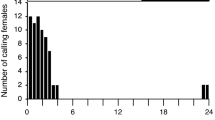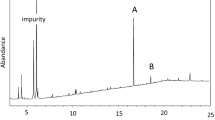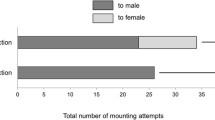Abstract
The major component of the female-produced sex pheromone of Scoliopteryx libatrix has been characterized by chemical analysis, synthesis, electrophysiological studies and field tests as (6Z,13)-methylheneicosene, probably the 13S-isomer. This is the first example of a branched chain alkene as a sex pheromone in the Noctuidae and is markedly different from the pheromones of other members of the family. The systematic position of S. libatrix, belonging to a monotypic genus of a one-member subfamily within the Noctuidae, may reflect the unusual structure of the sex pheromone.
Similar content being viewed by others
REFERENCES
Arn, H., Toth, M., and Priesner, E. 1992. List of Sex Pheromones of Lepidoptera and Related Attractants, 2nd ed. OILB SROP Publ., Paris, 179 pp.
Beck, H. 1960. Die Larvalsystematik der Eulen (Noctuidae). Berlin: 406 pp.
Beck, H. 1996. Systematische Liste der Noctuidae Europas (Lepidoptera, Noctuidae). Neue Entomol. Nachr. Entomol. Mus. Dr. Ulf Eitschberger. B. 36:1–122.
Brandsma, L. 1988. Preparative Acetylenic Chemistry. Elsevier, Amsterdam.
Buser, H.-R., Arn, H., Guerin, P., and Rauscher, S. 1983. Determination of double bond position in mono-unsaturated acetates by mass spectrometry of dimethyl disulfide adducts. Anal. Chem. 55:818–822.
Dunkelblum, E., Tan, S. H., and Silk, P. J. 1985. Double-bond location in monounsaturated fatty acids by dimethyl disulfide. Derivatization and mass spectrometry: Application to analysis of fatty acids in pheromone glands of four Lepidoptera. J. Chem. Ecol. 11:265–277.
Gries, G., Gries, R., Khaskin, G., Slessor, K. N., Grant, G. G., LiŠka, I., and Kapitola, P. 1996. Specificity of nun and gypsy moth sexual communication through multiple-component pheromone blends. Naturwissenschaften 83:382–385.
Gries, R., Gries, G., Skip king, G. G., and Maier, C. T. 1997. Sex pheromone components of the apple leaf miner, Lyonetia prunifoliella. J. Chem. Ecol. 23:1119–1130.
Hampson, J. 1903. Catalogue of the Lepidoptera Phalaena in the British Museum, 4. London, 1–4.
KÖnig, W. A. 1992. Gas Chromatographic Enantiomer Separation With Modified Cyclodextrins. Hütnig Buch Verlag, Heidelberg, 168 pp.
Kowalski, W. 1965. Ethological and ecological observations on Lepidoptera in their subterranean hibernating places in the vicinity of Cracow. Zesz. Nauk. Univ. Jagielono. Pr. Zool. 9:97–161.
Leraut, P. 1980. Liste Systematique et Synonymique des Lépidoptères de France, Belgique et Corse. Alexanor, Paris, 334 pp.
Maddrell, S. H. P. 1969. Secretion by the Malpighian tubules of Rhodnius. The movement of ions and water. J. Exp. Biol. 51:71–97.
Pomonis, R., Fatland, C. F., Nelson, D. R., and Zaylskie, R. G. 1978. Insect hydrocarbons I. Corroboration of structure by synthesis and mass spectrometry of mono-and dimethylalkanes. J. Chem. Ecol. 4:27–39.
Rossi, R., and Carpita, A. 1977. Insect pheromones: Stereoselective reduction of α-or ω-alkynols to the corresponding (E)-alkenols by lithium tetrahydroaluminate. Synthesis 1977:561–562.
Sato, R., Abe, N., Sonnet, P., Sugie, H., and Tamaki, Y. 1985. Biological activity of (R)-and (S)-14-methyl-1-octadecene, as the chiral component of the sex pheromone of the peach leafminer moth, Lyonetia clerkella Linné (Lepidoptera: Lyonetiidae). Appl. Entomol. Zool. 20:411.
Subchev, M., and Pilarska, D. 1997. Calling behavior and sex pheromone gland of Scoliopteryx libatrix L. (Lepidoptera, Noctuidae) females. Acta Zool. Bulg. 49:25–31.
Tikhomirov, A. M. 1978. Phylogenetic relationships in the family Noctuidae (Lepidoptera) on the base of study of functional morphology of the male genital apparatus. Trudy Zool. Inst. An S.S.S.R. 82:75–99.
Vasil'ev, V. P. (ed.). 1974. Pests on Agricultural and Forest Cultures, Vol. II: Harmful Arthropods, Vertebrates. Urozhaj, Kiev (in Russian).
Wadhams, L. J. 1990. The use of coupled gas chromatography: Electrophysiological techniques in the identification of insect pheromones, pp. 289–298, in A. R. McCaffery and I. D. Wilson (eds.). Chromatography and Isolation of Insect Hormones and Pheromones. Plenum Press, New York.
Wadhams, L. J., Angst, M. E., and Blight, M. M. 1982. Responses of the olfactory receptors of Scolytus scolytus (F.) (Coleoptera: Scolytidae) to the stereoisomers of 4-methyl-3-heptanol. J. Chem. Ecol. 8:477–492.
Wiley, G. A., Hershkowitz, R. L., Rein, B. M., and Chung, B. C. 1964. Studies in organophosphorus chemistry I. Conversion of alcohols and phenols to halides by tertiary phosphine dihalides. J. Am. Chem. Soc. 86:964–965.
Zhang, B.-C.H. 1994. Index of Economically Important Lepidoptera. University Press, Cambridge. 599 pp.
Zhu, J., Ryrholm, N., Ljungberg, H., Hansson, B. S., Hall, D., Reed, D., and lÖfstedt, C. 1996. Olefinic acetates, △-9,11–14: OAc and △–7,9–12: OAc used as sex pheromone components in three geometrid moths, Idaea aversata, I. straminata, and I. biselata (Geometridae, Lepidoptera). J. Chem. Ecol. 22:1505–1526.
Author information
Authors and Affiliations
Rights and permissions
About this article
Cite this article
Francke, W., Plass, E., Zimmermann, N. et al. Major Sex Pheromone Component of Female Herald Moth Scoliopteryx libatrix is the Novel Branched Alkene (6Z,13)-Methylheneicosene. J Chem Ecol 26, 1135–1149 (2000). https://doi.org/10.1023/A:1005475725742
Issue Date:
DOI: https://doi.org/10.1023/A:1005475725742




